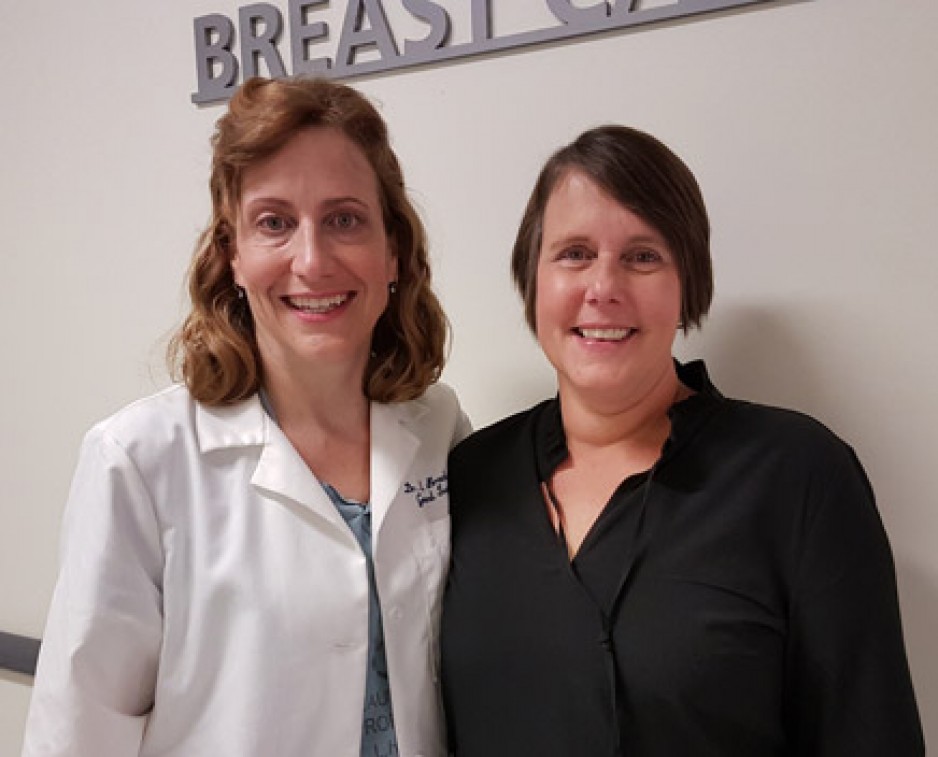New breast cancer surgery approach improves survivorship and leaves women looking and feeling whole
Surgical oncologist Dr. Muriel Brackstone is co-founder of Canada’s first, hands-on oncoplastic surgery course.
A London surgeon is leading a shift across Canada to new breast surgery techniques that are dramatically changing the outcome and quality of life for women diagnosed with breast cancer.
Stephanie Wilds, right, is thrilled with the results of her breast cancer surgery, which saved her breasts and left her looking better than before as well as cancer free. Her surgeon, Dr. Muriel Brackstone, is leading a shift to a new breast surgery technique, called oncoplastic surgery, that is dramatically changing the outcome and quality of life for women diagnosed with breast cancer.
About 80 per cent of women with breast cancer undergo a lumpectomy - surgery in which only the tumor and some surrounding tissue is removed. While much less drastic than a mastectomy, a large lumpectomy often leaves women with a significantly distorted breast.
Reducing the risk of the cancer returning
“What’s exciting is we can now perform surgery in a way that can not only reduce the risk of the cancer returning but also drastically improves the cosmetic outcome,” says surgical oncologist Dr. Muriel Brackstone, former Medical Director of the Breast Care Program of St. Joseph’s Health Care London. “Women are delighted. They are our some of our happiest patients. They look cosmetically better after their cancer operation than they did before, and their cancer is gone. They also tolerate the subsequent radiation better.”
It’s called oncoplastic surgery and it combines the latest plastic surgery techniques with breast surgical oncology. When a large lumpectomy is required, the remaining tissue is sculpted and molded to restore natural appearance. The technique includes a breast lift and reduction. The opposite breast may also be modified to create symmetry.
Dr. Brackstone is co-founder of the Oncoplastic Partnership Workshop, Canada’s first hands-on oncoplastic surgery course for practicing surgeons across the country. She is also Director of Western University’s Oncoplastic Breast Surgery Fellowship, one of two such fellowships in Canada that trains new surgeons in this technique. The innovative surgeon and researcher is the keynote speaker at St. Joseph’s Best in Breast Care Conference on Oct. 19, which is open to both clinicians and the public. (See below).
With improvements in breast imaging in recent years, pre-cancerous tissue in the vicinity of the cancer can now be more easily found, explains Dr. Brackstone. By removing those pre-cancerous lesions and the cancer, the risk of recurrence after radiation is low. The breast can be saved with good long-term outcomes, but it means a larger volume of the breast is removed.
“If we did that lumpectomy the way we used to – took the piece out and closed the skin – it initially looks good but then the fluid in that space gets reabsorbed resulting in contour deformity.”
Oncoplastic surgery is a new way of thinking for breast surgeons, says Dr. Brackstone. The more complex cases require a team approach with plastic surgeons.
“As a surgeon you’re thinking within the context of the cancer and in three dimensions with the final cosmetic view in mind.”
With oncoplastic surgery, larger breasted women can lose up to 60 per cent of their breast “and still have a beautiful, lifted reconstruction,” says Dr. Brackstone. Women don’t need prosthetics and can avoid posture and self-esteem issues that often arise with a significant breast deformity.
Cancer removed, breasts saved
Stephanie Wilds was 45 when diagnosed with invasive breast cancer in both breasts in July 2016. In the past, she would have undergone a double mastectomy but Dr. Brackstone was able to remove the cancer and save her breasts with oncoplastic surgery.
“When I was diagnosed I didn’t have hope that I would be here in five years,” says Stephanie. “I was blown away when I learned that I didn’t have to lose my breasts and that I would be around a lot longer than five years.”
While Stephanie lost about half of each breast, she is thrilled with the reduction and reshaping of her breasts. She is also cancer free.
“I look better than I did before. They are beautiful. They are perfect.” says the mom of two young girls, who also underwent 15 months of chemotherapy and intravenous immune-base therapy, along with six weeks of daily radiation therapy.
The purpose of the oncoplastic surgery workshop co-founded by Dr. Brackstone and four other Ontario surgeons is to provide surgeons with the skills they need and improve access to this enhanced care to patients no matter where they live.
“Stephanie is a great example of how we can look past the boundaries of our specialties as surgeons and work together to redesign what we do and how we do it,” says Dr. Brackstone. “Along with good outcomes in survivorship, the new technique helps restore femininity and a sense of wholeness.”
